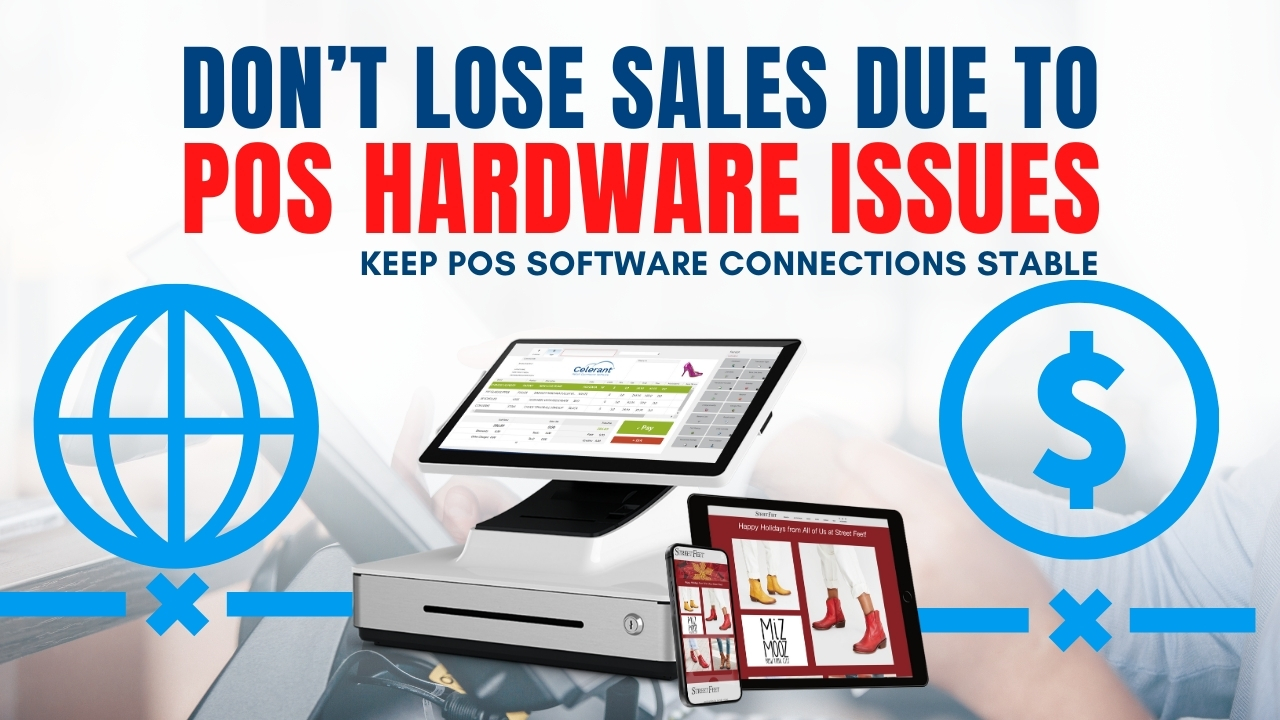Blog
Do Not Lose Store Sales due to POS Hardware Issues; Keep POS Software Connections Stable
May 10, 2024 / 9 minute read / By Zoya Naeem
 2024
2024Blog
 2024
2024The absolute worst scenario for any retailer is if your POS system goes down during a busy period.
Customers waiting in long lines, frustration building, and lost sales as a result can be a nightmare.
In today’s competitive retail environment, a reliable point of sale (POS) system isn’t a luxury; it’s the cornerstone of your business. A malfunctioning POS system can lead to more than a flustered cashier and a disappointed customer.
Studies show that technical glitches at checkout can cause significant lost sales in your store, which can translate to lost revenue and a potential tarnish on your brand reputation. When your POS software isn’t working smoothly, it can lead to delays and lost sales.
This article will discuss how to avoid these retailer nightmares by keeping your POS hardware connections stable.
When your point of sale (POS) system isn’t connecting properly, it can create a domino effect of issues that ripple throughout your store. All of which leads to:
Beyond just frustrating your customers, unstable connections can directly impact your bottom line. Every lost sale due to a glitch is lost revenue. Multiply that by the number of customers affected, and you can see how quickly those losses add up.
A variety of factors can cause unstable connections. Here’s a quick glimpse of some common culprits and how they disrupt your POS system’s communication:
| Cause | Explanation | Impact on Connections |
|---|---|---|
| Loose Cables | Damaged cables connecting POS components (scanner, printer) create weak or interrupted signals. | Intermittent connections and data transfer problems. |
| Faulty Equipment | Worn-out hardware malfunctions and struggles to maintain a stable connection. | Disruptions in communication between devices. |
| Wi-Fi Connectivity Problems | Weak or unreliable Wi-Fi signal leads to dropped connections and reconnects. | Disrupted data flow between POS and network. Risk of your store being down and not able to process sales. |
| Outdated Hardware | Older hardware might not be compatible with newer software updates, leading to malfunctions. | Connection issues and incompatibility with the system. |
Just like taking your car for regular oil changes, your POS system needs preventive maintenance too. Here’s how to keep it running smoothly:
Treat your POS system to regular checkups. Clean dust and debris from scanners, printers, and cash drawers. Regularly check your POS hardware, including printers, for ink/toner levels and paper jams, and ensure scanners are always dust-free.
During your busiest seasons, for example the holiday season, always ensure that you have enough receipt paper, labels, ink/toner, as well as gift cards and other items that are necessary and can often run out. Falling short with these types of supplies can disrupt your sales counter and cause unneeded frustrations at your busiest shopping times.
Inspect cash drawers for smooth operation and occasionally clean card readers to ensure optimal functionality. You must also inspect cables for any damage or wear and tear. Loose or frayed cables can cause intermittent connections and data transfer problems. Make sure all cable connections are secure and snug.
And don’t forget the software side.
Keeping your POS software up-to-date ensures compatibility with hardware and improves overall system performance. Look for updates that include bug fixes and security patches that can prevent connection issues in the long run.
Always opt for high-quality POS equipment from reputable point of sale providers known for their durability and performance. This upfront investment translates to fewer headaches down the road, ensuring your POS system runs smoothly and minimizes downtime.
You might also want to consider extended warranties or service contracts for added peace of mind. In case of hardware failure, these plans can cover replacements and repairs, often with expedited shipping, for minimal disruptions to your business.
For retailers with a single POS system or multiple busy stations, consider having an extra credit card processing pin pad device on hand. While it requires an upfront investment, a spare encrypted pin pad ensures you can keep processing payments even if your primary device runs into a problem or stops functioning. Waiting for a replacement device can take time, and lost sales during that wait can be costly. A backup ensures a seamless checkout experience and keeps your business running smoothly.
Is your POS system Wi-Fi dependent? If so, it’s important for you to have a strong and reliable internet connection. Frequent dropouts or slow internet speed can lead to delays and lost sales. Consider consulting an IT professional to optimize your network for smooth POS operations.
If feasible, explore wired ethernet connections for your POS system. Ethernet offers a more stable and secure connection than Wi-Fi, minimizing the risk of network disruptions.
Internet outages, though rare, can happen. Consider a hybrid POS system that can function offline. This ensures your retail store remains 100% operational even when the internet goes down, allowing you to complete sales and keep your customers happy.
Don’t let POS system hardware failure or power outages put a halt to your retail business. Having a robust data backup plan is essential for protecting your valuable sales data and ensuring the business keeps running without any hiccups. With regular backups you can create copies of your data that can be restored in case of hardware malfunction, accidental deletion, or even cyberattacks.
Consider investing in a power backup system designed to provide backup during outages. This ensures a smooth transition and data protection in case of a power flicker or a more extended power cut.
Today, many modern POS systems are cloud-based, offering automatic data backups stored securely offsite by your hosting provider. This eliminates the need for manual backups and ensures data accessibility even if your local hardware fails.
One of the best ways to maintain and monitor your POS system’s health is by training your staff.
Make sure your staff undergoes comprehensive POS system training that should cover proper operation procedures, troubleshooting common issues, and recognizing potential problems.
Well-trained staff can identify and report issues promptly, minimizing downtime and potential data loss. You should also make sure your staff is well-versed in tasks like restarting the system, clearing jams, or checking cable connections, as handling these minor hiccups keeps your checkout process running smoothly.
Maintaining a stable POS connection is crucial for a smooth and efficient checkout experience, as this translates to happier customers, better sales, and a thriving business.
From investing in high-quality hardware to empowering your staff -you can minimize downtime, ensure reliable connections, and keep your sales flowing.
At Celerant, our POS systems are designed for stability and efficiency. We offer a range of solutions to fit your specific needs, ensuring uninterrupted sales and efficient operations. We offer two solutions based on your business needs; Cumulus Retail for small business and Stratus Enterprise for advanced retail.
Not sure which of our retail software solutions are right for your business? Take our short quiz below to help you decide!
Ready to learn more about streamlining your business operations with Celerant POS? Tap the button below and learn:
 Explore four simple strategies to keep your first-time buyers coming back (with a little help from your… |
 How can retailers improve their email marketing metrics to achieve higher open rates, click through… |